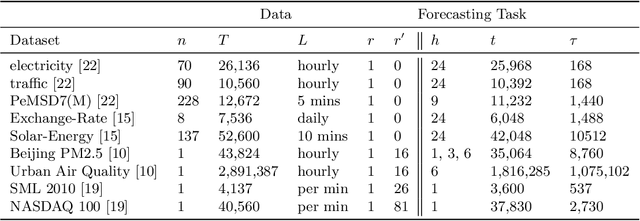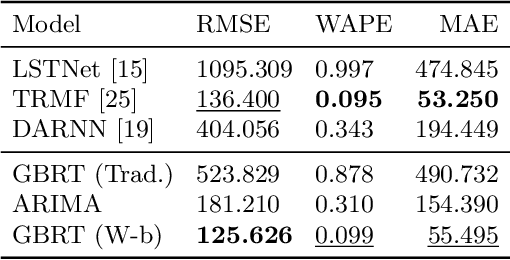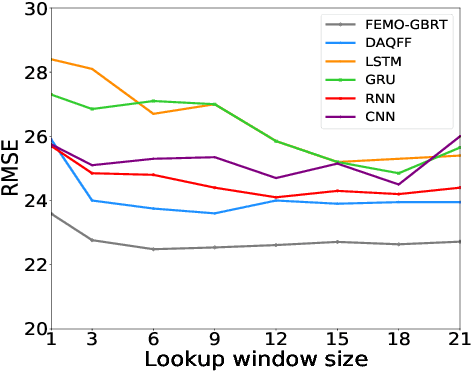Shereen Elsayed
HMAR: Hierarchical Masked Attention for Multi-Behaviour Recommendation
Apr 29, 2024Abstract:In the context of recommendation systems, addressing multi-behavioral user interactions has become vital for understanding the evolving user behavior. Recent models utilize techniques like graph neural networks and attention mechanisms for modeling diverse behaviors, but capturing sequential patterns in historical interactions remains challenging. To tackle this, we introduce Hierarchical Masked Attention for multi-behavior recommendation (HMAR). Specifically, our approach applies masked self-attention to items of the same behavior, followed by self-attention across all behaviors. Additionally, we propose historical behavior indicators to encode the historical frequency of each items behavior in the input sequence. Furthermore, the HMAR model operates in a multi-task setting, allowing it to learn item behaviors and their associated ranking scores concurrently. Extensive experimental results on four real-world datasets demonstrate that our proposed model outperforms state-of-the-art methods. Our code and datasets are available here (https://github.com/Shereen-Elsayed/HMAR).
Context-Aware Sequential Model for Multi-Behaviour Recommendation
Dec 15, 2023Abstract:Sequential recommendation models are crucial for next-item recommendations in online platforms, capturing complex patterns in user interactions. However, many focus on a single behavior, overlooking valuable implicit interactions like clicks and favorites. Existing multi-behavioral models often fail to simultaneously capture sequential patterns. We propose CASM, a Context-Aware Sequential Model, leveraging sequential models to seamlessly handle multiple behaviors. CASM employs context-aware multi-head self-attention for heterogeneous historical interactions and a weighted binary cross-entropy loss for precise control over behavior contributions. Experimental results on four datasets demonstrate CASM's superiority over state-of-the-art approaches.
Deep Multi-Representation Model for Click-Through Rate Prediction
Oct 18, 2022



Abstract:Click-Through Rate prediction (CTR) is a crucial task in recommender systems, and it gained considerable attention in the past few years. The primary purpose of recent research emphasizes obtaining meaningful and powerful representations through mining low and high feature interactions using various components such as Deep Neural Networks (DNN), CrossNets, or transformer blocks. In this work, we propose the Deep Multi-Representation model (DeepMR) that jointly trains a mixture of two powerful feature representation learning components, namely DNNs and multi-head self-attentions. Furthermore, DeepMR integrates the novel residual with zero initialization (ReZero) connections to the DNN and the multi-head self-attention components for learning superior input representations. Experiments on three real-world datasets show that the proposed model significantly outperforms all state-of-the-art models in the task of click-through rate prediction.
End-to-End Image-Based Fashion Recommendation
May 05, 2022



Abstract:In fashion-based recommendation settings, incorporating the item image features is considered a crucial factor, and it has shown significant improvements to many traditional models, including but not limited to matrix factorization, auto-encoders, and nearest neighbor models. While there are numerous image-based recommender approaches that utilize dedicated deep neural networks, comparisons to attribute-aware models are often disregarded despite their ability to be easily extended to leverage items' image features. In this paper, we propose a simple yet effective attribute-aware model that incorporates image features for better item representation learning in item recommendation tasks. The proposed model utilizes items' image features extracted by a calibrated ResNet50 component. We present an ablation study to compare incorporating the image features using three different techniques into the recommender system component that can seamlessly leverage any available items' attributes. Experiments on two image-based real-world recommender systems datasets show that the proposed model significantly outperforms all state-of-the-art image-based models.
CARCA: Context and Attribute-Aware Next-Item Recommendation via Cross-Attention
Apr 04, 2022



Abstract:In sparse recommender settings, users' context and item attributes play a crucial role in deciding which items to recommend next. Despite that, recent works in sequential and time-aware recommendations usually either ignore both aspects or only consider one of them, limiting their predictive performance. In this paper, we address these limitations by proposing a context and attribute-aware recommender model (CARCA) that can capture the dynamic nature of the user profiles in terms of contextual features and item attributes via dedicated multi-head self-attention blocks that extract profile-level features and predicting item scores. Also, unlike many of the current state-of-the-art sequential item recommendation approaches that use a simple dot-product between the most recent item's latent features and the target items embeddings for scoring, CARCA uses cross-attention between all profile items and the target items to predict their final scores. This cross-attention allows CARCA to harness the correlation between old and recent items in the user profile and their influence on deciding which item to recommend next. Experiments on four real-world recommender system datasets show that the proposed model significantly outperforms all state-of-the-art models in the task of item recommendation and achieving improvements of up to 53% in Normalized Discounted Cumulative Gain (NDCG) and Hit-Ratio. Results also show that CARCA outperformed several state-of-the-art dedicated image-based recommender systems by merely utilizing image attributes extracted from a pre-trained ResNet50 in a black-box fashion.
A.I. and Data-Driven Mobility at Volkswagen Financial Services AG
Feb 09, 2022Abstract:Machine learning is being widely adapted in industrial applications owing to the capabilities of commercially available hardware and rapidly advancing research. Volkswagen Financial Services (VWFS), as a market leader in vehicle leasing services, aims to leverage existing proprietary data and the latest research to enhance existing and derive new business processes. The collaboration between Information Systems and Machine Learning Lab (ISMLL) and VWFS serves to realize this goal. In this paper, we propose methods in the fields of recommender systems, object detection, and forecasting that enable data-driven decisions for the vehicle life-cycle at VWFS.
Do We Really Need Deep Learning Models for Time Series Forecasting?
Jan 06, 2021



Abstract:Time series forecasting is a crucial task in machine learning, as it has a wide range of applications including but not limited to forecasting electricity consumption, traffic, and air quality. Traditional forecasting models relied on rolling averages, vector auto-regression and auto-regressive integrated moving averages. On the other hand, deep learning and matrix factorization models have been recently proposed to tackle the same problem with more competitive performance. However, one major drawback of such models is that they tend to be overly complex in comparison to traditional techniques. In this paper, we try to answer whether these highly complex deep learning models are without alternative. We aim to enrich the pool of simple but powerful baselines by revisiting the gradient boosting regression trees for time series forecasting. Specifically, we reconfigure the way time series data is handled by Gradient Tree Boosting models in a windowed fashion that is similar to the deep learning models. For each training window, the target values are concatenated with external features, and then flattened to form one input instance for a multi-output gradient boosting regression tree model. We conducted a comparative study on nine datasets for eight state-of-the-art deep-learning models that were presented at top-level conferences in the last years. The results demonstrated that the proposed approach outperforms all of the state-of-the-art models.
 Add to Chrome
Add to Chrome Add to Firefox
Add to Firefox Add to Edge
Add to Edge